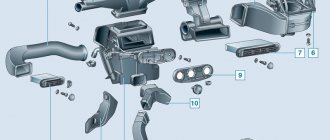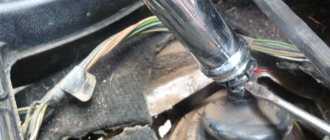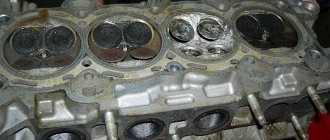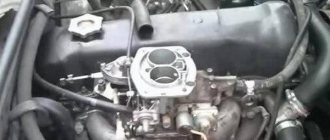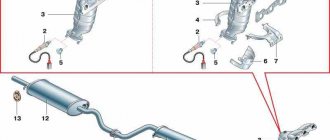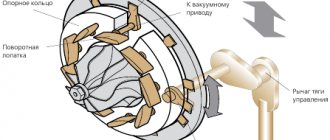How to repair and adjust the turbine actuator yourself
Turbocharging today is one of the most common methods that allows you to significantly increase the power of a gasoline or diesel engine without increasing the displacement of the power unit. Installing a turbocharger is also a more efficient solution compared to mechanical superchargers.
The basis of turbocharging is the supply of air to the cylinders of the internal combustion engine under pressure. The more air you can supply to the engine, the more fuel you can burn. Civilian versions of turbo engines do not have too much boost, which is enough to achieve the required performance. It is quite obvious that in order to achieve maximum performance, turbines are installed on the engines, which are capable of providing high pressure. In this article we will talk about why an actuator on a turbine is needed, what is the principle of operation of a turbine actuator, as well as how to check a turbine actuator and configure this element.
Turbocharger device.
- Turbine with impeller.
- Air centrifugal pump.
- Compressor.
- A rigid axis that connects them.
- Bearings, rings, valves, seals and other small parts.
These malfunctions do not always relate to problems with the turbocharger; sometimes it can be something else, for example, you need to repair the muffler yourself.
Exhaust gases escape from the engine and enter the turbine impeller. It converts their energy from kinetic to mechanical, and the pump through the air filter supplies fresh air to the compressor, which compresses it and sends it to the engine. This entire process helps increase engine power by 20-50%!, increasing efficiency and fuel burning rate.
What are the types of turbocharger malfunctions and how to recognize them?
- Your engine suddenly seems to lose power.
- Black or dark blue smoke comes out of the exhaust pipe.
- Oil consumption has increased.
- The sound of the engine and turbocharger has changed.
All this indicates that it’s time to make sure you have a turbocharger repair kit and check the serviceability of not only the turbocharger, but also, first of all, the car’s engine and all its attachments. Do not neglect this advice, because a well-maintained and properly functioning engine ensures trouble-free operation of the turbocharger for many years.
Common Wastegate Problems
Now let's talk about common malfunctions in which replacement of the turbine actuator is inevitable or repair of this element is required. Let's start with the fact that there are several reasons for the failure of this part. First of all, electronic components break down, the electric motor may malfunction, and the teeth of the valve drive gears also break.
In some cases, the problem is eliminated after diagnosis at specialized turbine repair services. Specialists check the functionality of the controller and perform a number of tests. A common malfunction that repair of a turbine actuator without replacement can help eliminate is a failed cuff (turbine actuator membrane).
In the mid-day case, significant mileage and natural wear of parts lead to breakdown, and as a result, the specified cuff is often damaged. To eliminate it, it is necessary to remove the turbine actuator, after which the old membrane is removed from the housing. Next, the surfaces should be degreased, after which the new cuff is glued to the body with two caps and additionally undergoes a circular rolling process. Then the turbine actuator is adjusted.
Common turbine actuator malfunctions
There are three main reasons why a wastegate breaks:
- The electronic components of the system component, which are responsible for its timely opening/closing, fail;
- The teeth of the drive gear break, which leads to difficulties when opening and closing the valve;
- Failure of the electric motor, which is responsible for the operation of the sash, as a result of which the system does not function properly.
In a specialized service center, you can eliminate all the problems described above, but it is important to note that first you need to correctly diagnose the breakdown, which will require special testers. Accordingly, independent repair of the turbine actuator is often impossible due to the lack of necessary equipment
Most often, when a turbine valve fails, it is more advisable not to repair it, but to replace it. This is especially true when cuffs or valve stem seals fail and cannot be replaced. In this case, you will need to remove the turbine actuator and install a new one in its place. This is done as follows:
The first step is to remove the old cuff from the case; Next, it is extremely important to degrease the surfaces so that they are tightly bonded to each other; After this, using sealed glue, you need to stick a new cuff onto the body with two caps; To create the necessary vacuum, a gap is created between the caps, at the same time additional lubrication is provided; Next, the membrane is attached using glue, and it is important to roll it around the entire circumference.
At this point, the installation of the activator can be considered complete. All that remains is to configure it so that it works correctly with the system.
How to adjust the turbine actuator
The need to adjust the wastegate is indicated by the appearance of a recognizable rattling sound at the installation site of the turbocharger at the moment when the engine is turned off. Vibrations and rattling also appear during gas pumping, at the moment of releasing gas. Such rattling appears as a result of the fact that the actuator rod begins to dangle; the rattling sound itself is created by the “gate” of the regulator. Insufficient air pressure will also indicate problems with the actuator if no problems were found with the inlet seal and other elements of the turbocharging system.
I would also like to add that many drivers resort to manipulating the wastegate not only because of problems, but also in order to increase performance and boost pressure, that is, they implement a kind of tuning of the system.
- To increase blood pressure, there are several options available. The simplest is to replace the regulator spring. The more elastic the spring is, the more pressure the turbine will produce until the valve is activated.
- Another option is to tighten or loosen the end of the regulator, which directly affects the opening and closing of the damper. If the end is relaxed then the valve rod lengthens, tightening will result in shortening. The shorter the pull, the tighter the damper will close. Accordingly, greater pressure and time will be required to open. This allows the turbine to reach high speeds, and this happens quite quickly.
- The third option for increasing boost is a boost controller. This mechanism is a solenoid that can replace real pressure data. Such a device is placed in front of the actuator; the main task is to reduce the pressure on which the operation of the wastegate depends. The boost controller actually partially bypasses the air, which prevents the actuator from assessing the actual pressure.
To set up and adjust the wastegate, you need to get to the adjusting nut. This can be done after removing the turbine. Also, on some vehicles, access can be obtained without removing the turbocharger. It is enough to get to the bypass installation site. Tightening the specified nut allows you to shorten the rod, as a result of which the “gate” will be closed more tightly. To perform this work, it is advisable to remove the catalyst in advance. This will allow you to determine by eye the degree of closure of the actuator. To adjust, you need to have a wrench for the adjusting nut (a 10 wrench is suitable) and pliers. The whole process consists of the following steps:
- at the very beginning, the bracket is removed from the rod, then the nut is loosened with a wrench;
- then use pliers to tighten the wastegate adjusting screw. This must be done counterclockwise;
- the tightening occurs until the gate is completely closed;
The completion of the adjustment process can be considered tightening the nut with a 10mm wrench, as well as installing the bracket in place. As a result, after such adjustment, the actuator should have a maximum degree of closure. Afterwards, you can start the engine and check the operation of the device in different operating modes of the internal combustion engine. There should be no extraneous sounds from the wastegate during throttle changes or when turning off the engine; the boost pressure also predictably reaches the desired values.
Qualified servo tuning
buy a turbine actuator from us with subsequent adjustment. Without proper tuning, when over-gasping, you will feel a serious vibration in the turbine, which does not stop after the engine stops. Poor tuning can cause insufficient boost. There are three ways to configure the actuator:
- The simplest option is to replace the spring with a more elastic part that increases the pressure. If it is necessary to reduce the pressure, a soft spring is installed.
- By loosening the end of the servo drive, you can significantly increase the thrust in the bypass valve, and by tightening the end, you can reduce the thrust, which will allow you to press the damper more tightly, causing a slower unwinding of the impeller.
- You can increase the boost by installing a boost controller that changes the actual pressure reading. To reduce the applied pressure, the element is installed before the wastegain. By releasing some of the air on its own, the boost controller reduces the load on the actuator.
Each of these methods has certain advantages and disadvantages.
Turbine actuator: how it works and what it is needed for
Many drivers prefer to tune the engine with a turbocharger. This is a unit whose correct name is a turbine actuator. If configured correctly, the device can seriously increase the power characteristics of the motor. Nowadays, high-pressure actuators are widely used. The design of the device has a valve that prevents pressure from increasing when the engine operates at high speeds.
What is a turbine actuator in a car? Principle of operation
- What is a turbine actuator in a car? Principle of operation
- Turbine actuator
- Subtleties of setting up the turbine actuator
- Features of gearbox actuators
- Application of actuators
- Clutch Actuator
- Cause of actuator failure
- Sources:
An actuator is a technical device or trigger mechanism that transmits force from the controller to the controlled object.
The impact itself can be varied: from linear to rotating.
How does a diesel engine turbine actuator work?
In the slang of car enthusiasts, this unit has different names - for example, wastegate, vacuum regulator. Like other mechanical components, the actuator can break, and then in order to continue operating the turbocharged engine, it must be replaced. But replacement is not so bad. Then the wastegate will have to be adjusted, and this is a serious task that only an experienced driver can perform correctly.
The regulator is placed in the exhaust manifold of the car. The principle of its operation is simple. As the speed increases, the engine begins to operate at higher speeds. The exhaust gas pressure increases. It becomes necessary to guide it past the turbine wheel. Then the wastegate begins to operate - its valve opens and allows gases to pass through itself.
Turbine actuator does not work: signs
There are several symptoms of a turbocharger failure, but the main one is blue exhaust. It is especially pronounced during acceleration, but when the operation of the power unit stabilizes, the exhaust acquires its normal color. The smoke turns blue due to the combustion of oil that entered the engine due to its leakage from the turbocharger.
Black smoke may also come out of the exhaust pipe, which indicates the combustion of enriched fuel due to an air leak in the intercooler. The exhaust may also be black due to a breakdown of the turbocharger control system.
White smoke also indicates a turbocharger malfunction. The exhaust turns white due to a blockage in the turbine oil line drain. Other obvious signs of actuator malfunction are oil leaks on the turbine and a significant increase in its consumption. This is evidence of a blockage in the air supply channels or oil pipeline.
If the car starts to accelerate slower than usual, the problem may also be with the turbocharger. Its malfunction may cause insufficient air mass to enter the power unit. Lack of air leads to a serious drop in engine power.
Another sign of a breakdown in the turbine is loud noise when the engine is running. Its appearance is caused by air leakage between the compressor outlet and the motor. Along with the noise, an unpleasant grinding noise appears when the turbocharger is turned on. Grinding or noise may be the result of cracks, dents, or other mechanical damage that the unit blades touch.
Why do you need to adjust the turbine actuator?
Indeed: it would seem that you installed a new part on the engine and use it! But here such a moment will not pass: in the absence of proper adjustment in the area where the turbocharger is located, trembling (rattling) of the device will be observed (it is especially strongly felt when the engine is revved up and stopped). Another consequence of incorrect adjustment (or lack thereof) is low boost.
Nuances: the last problem can also appear if there is a lack of tightness in the intake system. On some car models, a malfunction is signaled by the on-board computer, which writes, for example, “weak boost.”
How to check the turbine actuator?
Diagnosis of an electronic turbocharger begins with a test with a tester. The actuator can be tested on the car, or it can be pre-dismantled. The following are subject to verification:
- vacuum valve;
- actuating mechanism;
- turbine valve.
Diagnostics should be carried out periodically, even if the wastegate does not cause it. When a minor breakdown of the turbine occurs, this leads to excessive heating of the bearings and, as a consequence, to complete breakdown of the unit.
Testing can be done like this: start the engine and accelerate in place. In this case, you need to look at the wastegate rod - at some point it will start to move. Remember at what engine speed the turbocharger started to operate - this will be a guideline for checking its serviceability. More accurate readings can be obtained at the stand.
Setting up the turbine actuator
The turbine actuator must be adjusted. If this is not done, the entire system will shake while the engine is running. If the adjustment is made incorrectly, the boost will be insufficient. However, incomplete boost may occur if the system's intake has lost its tightness.
Let's start setting up. You can do it in different ways:
- Increase the pressure by replacing the old spring with a more elastic one. If, on the contrary, you need to reduce the pressure, you can install a spring made of mild steel. To lengthen the thrust of the bypass valve, you need to loosen the end of the actuator; to decrease it, on the contrary, tighten it. If the thrust is reduced, the damper will be pressed tighter. Then, to open it, you will have to apply significant force, which means the impeller will spin faster.
- You can increase the boost by installing a boost controller. This mechanism is capable of changing pressure. In order for it to reduce pressure on the wastegate, it must be installed in front of it. The boost controller takes on some of the load as it releases some of the air.
Stem setting
To remove the overblowing, you need to shorten the rod by tightening the adjusting nut (that is, turning it clockwise). Then the blades of the geometry will not open too much. If you need to correct the under-inflating, you need to do the opposite - unscrew the adjusting nut.
Actuator replacement: when is it required?
Sometimes the turbine fails immediately, but usually it happens gradually. To detect a breakdown at an early stage, you need to take a closer look at the operation of the machine. If all efforts to repair this device fail, you will have to buy a new actuator.
Previously, replacement was carried out together with the turbine, but now the actuator can be replaced separately. Some technicians generally recommend not trying to repair this device, but replacing it immediately - unless, of course, the problem is a soured connection. The unit will definitely have to be replaced if the rod joint on the regulator is worn out. This work is not that difficult. After replacing the device, it will take time to adapt.
Aggressive driving style and the use of low-quality fuel and engine oil lead to premature failure of the actuator. In order for the unit to last longer, this should not happen - it is better to use only certified technical fluids.
The turbine drives oil into the intercooler: what to do?
The oil in the intercooler can cause serious malfunctions, including failure of the internal combustion engine. In this article we will tell you why oil appears in this unit and how you can fix this problem.
How to repair a turbocharger?
A turbocharger is a part that can significantly reduce engine fuel consumption. Repairing a turbocharger is quite difficult; professional tools are required.
Turbocharged engines and features of their operation
Turbocharged power units: their design features, performance characteristics and the most common causes of breakdowns.
Application of two-way valves in automotive systems
Since numerous vehicle systems constantly require shutting off, redirecting and mixing various flows of liquids or gases, the use of various bypass devices, such as valves, is required. The principles of their operation are based on different drives: pneumatic,
Turbocharging system on diesel engines
Many modern cars use turbochargers to increase engine power. They come in different types and shapes, but the principle of their operation is the same. The idea of turbocharged engines arose a long time ago. Some of the first turbochargers were installed on racing cars at the beginning of the last century.
Possibility of installing a turbocharger on atmospheric power units
The idea of turbocharging power units arose out of the need to economically increase engine power. Adding power by simply increasing the volume has become impractical, since this leads to significant fuel consumption. Turbocharger technology is based on air supply to the chamber
Do-it-yourself turbocharger repair - causes of malfunctions and instructions
Just ten years ago, a car turbocharger moved from the category of a special chic inherent only in selected cars to the category of a necessary part for every car. It serves to increase engine power and helps reduce fuel consumption. These parameters are becoming increasingly popular when choosing a car. Therefore, today every driver needs to know the structure of a turbocharger and be able to understand what its malfunctions are in order to navigate and diagnose the breakdown of his car in time. In addition to the design of the turbocharger, you should also know the features of your car model; for this you should read the repair and operating instructions for your car, for example, the repair instructions for GAZ 3110 and Chevrolet Lanos.
We recommend: DIY starter repair
How to check a turbine actuator
A car is a constant assistant for almost half of the country’s population. It's not surprising that many people try to get the most out of their car with minimal investment. And today, in order to improve the traction characteristics of a car, you don’t need to change anything radically. You can increase the traction characteristics of the car simply by installing turbocharging.
The essence of the improvement is that turbocharging allows you to forcibly increase the volume of air supplied to the combustion chamber, thereby improving the fuel combustion process without the need to physically change the parameters of the engine itself.
It is important to consider here that a larger volume of burned fuel increases the pressure and volume of exhaust gases. Therefore, enhanced, prompt removal is required to make room for a new portion of air. This is the basis of the operating principle of the turbine actuator, which we will consider today.
Repair of turbine vacuum actuators
If at this stage there are suspicions about the incorrect operation of the actuator or its obvious malfunction is determined, dismantling is carried out. Its operation is checked on a special vacuum stand. If there is a deviation from the operating parameters, the actuator is disassembled.
On most designs, the body parts are connected to each other by rolling, which greatly complicates disassembly. This requires special equipment and highly qualified mechanics to avoid causing critical damage to body parts.
After opening the housing, the actuator is disassembled into its component parts and troubleshooting is carried out. The body is inspected for through corrosion damage. If in the part with the hole for the rod the presence of minor damage is acceptable, then in the vacuum chamber such a defect will cause complete failure.
The condition of the sealing sleeve in the hole for the rod is inspected. Large output can cause the rod to become distorted, which will affect the correct operation of the entire system.
The cuff is checked for tears or other damage. If there are even small defects, the cuff is considered unsuitable for further use.
The condition of the spring, its integrity and elastic qualities are assessed. If the spring has lost its stiffness or is severely corroded, it is replaced with a new one.
The condition of the work plate is inspected. Particular attention is paid to the safety of its geometry and the point of attachment of the rod. If geometry violations or rod play are detected, repairs are carried out.
After a complete inspection of all components of the vacuum actuator, the feasibility of its repair is assessed. Sometimes, if there is multiple damage, it is more economically feasible to purchase a new actuator.
How does a turbine actuator work?
First, let's define the terminology. An actuator can have many colloquial names - wastegate, vacuum regulator , excess valve . All this is one part, the basic role of which is to perform the function of relieving high air pressure (exhaust gases) while the car engine is running. This element acts as an intermediate link between the turbocharger and the engine, protecting them from overload.
It is installed practically on the turbine.
- The operating principle of the actuator boils down to the fact that at high engine speeds, when the pressure of the exhaust gases on one side and the air directed through the turbocharger into the engine on the other increases, the valve opens and stabilizes the situation. When the valve opens, some of the exhaust gases simply pass by the turbine wheel, which leads to a decrease in the efficiency of the turbine blower wheel and reduces air pressure.
Reducing the pressure of the exhaust gases and directing them bypassing the turbine wheel is carried out through a wastegate controlled by an actuator. Thus, the need for air for the combustible mixture clearly corresponds to the moment the combustion chamber is cleaned of exhaust gases.
Other types of actuators
Variable geometry turbines also have actuators, which can be either electric or pneumatic (vacuum). In this case, the actuators serve to rotate the blades of the variable geometry mechanism. Typically, such turbines do not have a wastegate with high pressure actuator control.
The most common actuator failures
- damage to electrical components;
- wear of the gear teeth and worm of the electric actuator;
- the electric motor fails;
- damage to the vacuum actuator membrane.
Turbine actuator: operating features
An actuator, also known as a wastegate or vacuum regulator, is a valve for relieving excess air pressure at high engine speeds. The purpose of this solution is to provide a kind of protection for the turbocharger and engine. The specified regulator for protection against excess loads is located in the exhaust manifold (in fact, on the turbine itself); the installation location is the area in front of the turbine.
The wastegate works according to the following principle: if the engine speed is high, resulting in an increase in exhaust gas pressure and charge air pressure, then the valve opens. Its opening redirects part of the exhaust gases bypassing the turbine wheel.
In other words, the exhaust gases rotating the turbine wheel impeller and the shaft on which the compressor wheel impeller is mounted in parallel are bypassed. As a result, the turbine operating intensity decreases and the air supply to the internal combustion engine cylinders decreases.
This happens when the turbine wheel is spun by the exhaust gases to too high a speed, as a result of which the actuator initiates the operation of the bypass valve, that is, the exhaust gases pass by the turbine wheel. It turns out that the wastegate simply does not allow the turbocharger to spin up to its maximum under the influence of too strong exhaust flow at high engine speeds.
Let's add that turbo engines are initially precisely tuned from the factory. When tuning an internal combustion engine or installing a turbocharger on an atmospheric engine, the actuator must be configured separately. Setting up and adjusting the turbine actuator is an important point, since the health of the engine and turbocharger depends on the normal operation of the system. It is advisable to configure the wastegate using special equipment, but you can also do it yourself, which we will discuss below.
Checking the actuator
Initially, at the time of implementation, the actuator has factory settings and, in fact, is ready for operation. But after installation on the vehicle, it is advisable to check the actuator and adjust it. A typical signal to perform such actions will be the rattling of the compressor when the car engine is turned off. There is no need to panic here, this is not a breakdown of the actuator. The valve stem simply dangles excessively during operation.
In addition, often, if you configure the actuator correctly, you can significantly increase the performance of the turbocharger by increasing the air pressure supplied to the engine.
Adjustment is carried out in several ways
- The simplest and most common way is to simply replace the spring with a more powerful one. This will increase and maintain high turbine pressure until the exhaust valve is activated. But this is fraught with excess turbine shaft speed.
- The next option is to tighten (you can tighten or loosen) the regulator, which affects the process of opening and subsequent closing of the damper. As you relax, the pull lengthens. If you pull it a little, it shortens. The closure density of the damper directly depends on the length of the rod. The smaller it is, the tighter the damper will fit. Therefore, it takes more pressure and time to open it. Thus, the turbine is able to provide high speeds in a short period of time.
- Another option is to install a boost controller. The device is installed in front of the wastegate and provides a decrease in pressure at which the actuator membrane is activated. In fact, such a device takes on part of the pressure regulation function, as a result of which the valve does not receive information about the real gas pressure and continues to operate as normal.
Actuator setup
Of course, turbine repairs should be carried out in professional service centers that have all the necessary diagnostic equipment and spare parts if anything needs to be changed. However, the usual setup can be done at home.
To do this you will need pliers and a 10mm wrench. The sequence of actions will be as follows:
- Remove the turbocharger (some car models make it possible to get to the valve without having to perform this procedure).
- Remove the bracket from the rod, loosen the nut, tighten the adjustment screw (must be turned to the left).
- Lightly tap the valve. Tighten until the slight rattling goes away. Keep in mind that the tighter you tighten, the more pressure on the membrane will increase.
- Tighten the nut and return the bracket to its original position.
To check the correctness of your actions with the settings, start the engine and test it in different operating modes. If all actions were correct, there will be no extraneous sounds, including when the engine is turned off.
In order to identify a turbocharger, it is necessary to correctly “read” the information plate that is installed on it.
Below are photographs of information plates of the most common turbochargers - Garrett, Mitsubishi, IHI, KKK, Holset with a description of the information printed on them.
Turbine actuator aka Wastegate, or turbine control valve
As the English name suggests, this turbine control valve
serves to discharge excess exhaust gases rotating the rotor impeller through the outlet, or bypass, channel. If this is not done, the shaft will acquire excessive speed at high crankshaft speeds, which is fraught with an emergency increase in boost pressure, and with the throttle closed, a surge in the supercharger. Reducing the performance of the compressor will not help, then its capabilities at low and medium speeds will not be enough, the engine will fall into the so-called “turbo lag”. Device failures are associated precisely with cases of excess or lack of injection flow. Let's take a closer look at their manifestations.
Wastegate - a limiter in the service of increasing power
Some turbochargers do without bypass mode. These are low-pressure turbines; due to their compactness and low performance, they do not operate in modes that require limiting the flow from the hot side. Sometimes it is enough to dump the excess at the output, for which a simpler device is used.
The situation is different with powerful turbochargers, capable of creating very high pressure at high flow rates. Here you will need to limit the exhaust gas flow to a more efficient impeller.
Turbine control valve: design and principle of operation
Turbine valve
consists of a body divided by an elastic membrane into two parts. The first receives the control action of the air supplied to the inlet, and from the second comes a spring-loaded rod mechanically connected to the diaphragm. As soon as the force per unit area of the membrane exceeds a certain value, the spring will compress and the rod will move, opening the exhaust bypass channel. Gases will be directed around the turbine wheel, and its rotation speed will decrease.
Attention
Symptoms of turbine actuator malfunctions
Abnormal condition of the turbine actuator
implies two deviations from normal engine operation - excessive turbine pressure and insufficient pressure, depending on the specific nature of the breakdown.
- the wastegate
“wicket” fails to close, the turbine will rotate at higher speeds, that is, overinflate. Even if no mechanical damage occurs in the unit, which is very likely, the engine will begin to receive an excess amount of air. The consequences will be an over-lean mixture, up to misfire, detonation in the cylinders, and rapid failure of spark plugs. - If the gate is constantly open, the compressor will not be able to develop the required performance and air flow. The engine will lose power, the car will not be able to accelerate vigorously, and fuel consumption will certainly increase due to the over-enriched mixture. This will especially affect transition regimes.
- Intermediate states of uncertain actuator operation
. A characteristic sound of valve rattling will appear, in particular when idling and stopping the engine, power and torque will become uneven, jerking and pick-ups are possible.
Causes of breakdowns, diagnostics, repair possibilities
The main problem with the turbine actuator
– aging of the diaphragm and loss of its tightness. The valve stops responding to changes in output pressure and does not control the opening of the bypass. Checking this is quite simple, just blow into the receiving fitting. There should be no signs of air chamber leakage.
A damaged diaphragm can be replaced if spare parts are available. The wastegate body is flared, the membrane is removed from it and replaced with a new one. At the same time, contaminants are removed from the housing.
It will be more productive to replace the actuator with a new one. Reliability with such repairs is higher.
Available options
Not all actuators look or perform the same. They are divided into:
- purely pneumatic,
- operating under electronic control,
- hybrid, for example, having an air reducer at the control input. It, in turn, can be controlled from an electronic programmable unit that regulates maximum turbocharging - a boost controller. This variety of designs allows you to more accurately control the turbo engine depending on the situation.
But knowing the operating principle of the turbine actuator
and the nature of the manifestation of its probable breakdowns, you can determine the need to repair any complex structure if alarming symptoms appear.
Sources:
https://rem-turbo.ru/blog/diagnostika-elektronnogo-aktuatora-turbiny-na-avtomobile-i-diagnostika-snyatogo-elektronnogo-aktuatora/ https://krutimotor.ru/remont-i-nastrojka-aktuatora- turbiny/ https://mashinapro.ru/1827-aktuator-turbiny-kak-rabotaet-i-dlya-chego-nuzhen.html https://www.proturbo66.ru/stati/aktuator-turbiny.html https:// turborotor.com.ua/articles/104-aktuatory-turbin—prichiny-i-sledstvija-problem-s-vestgejt-klapanom-turbonadduva
